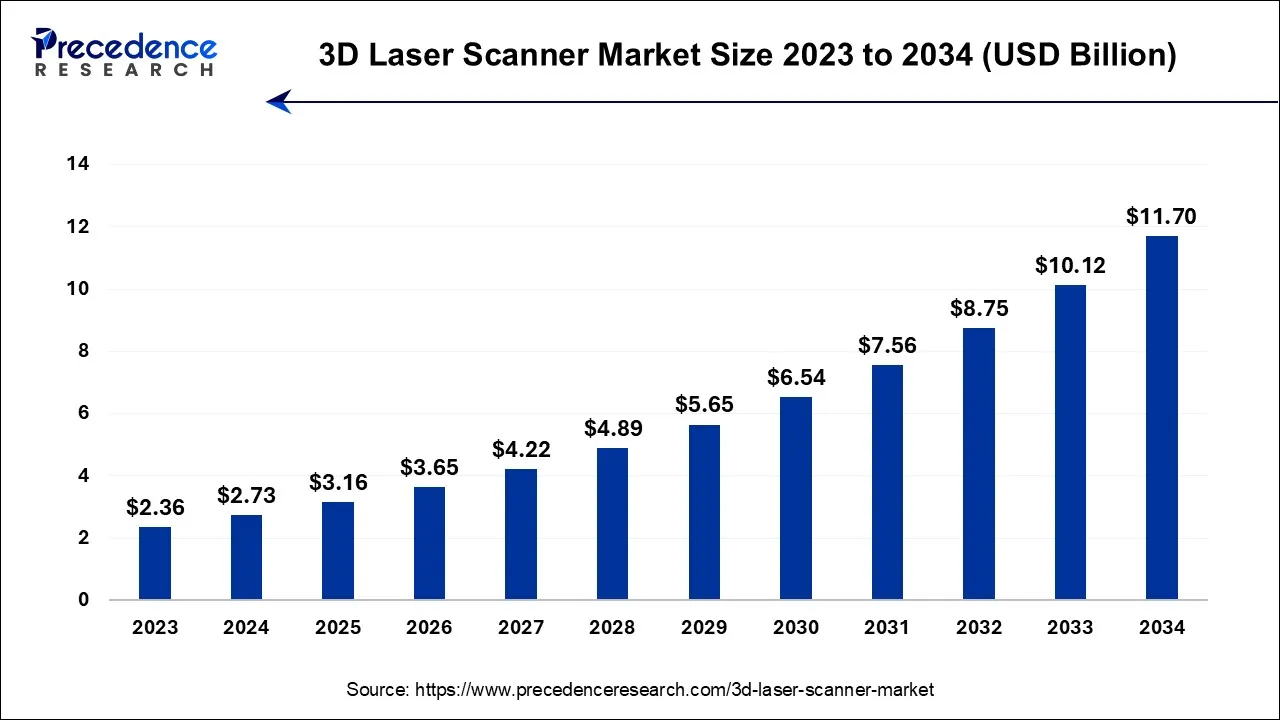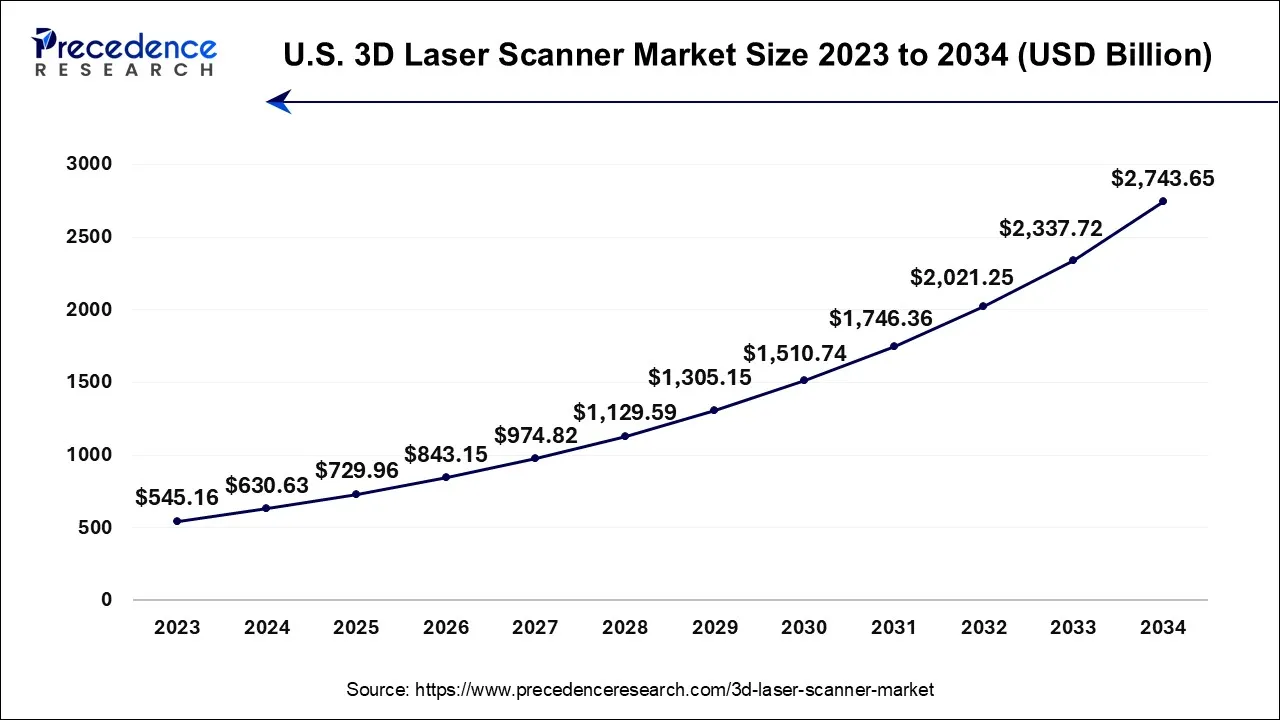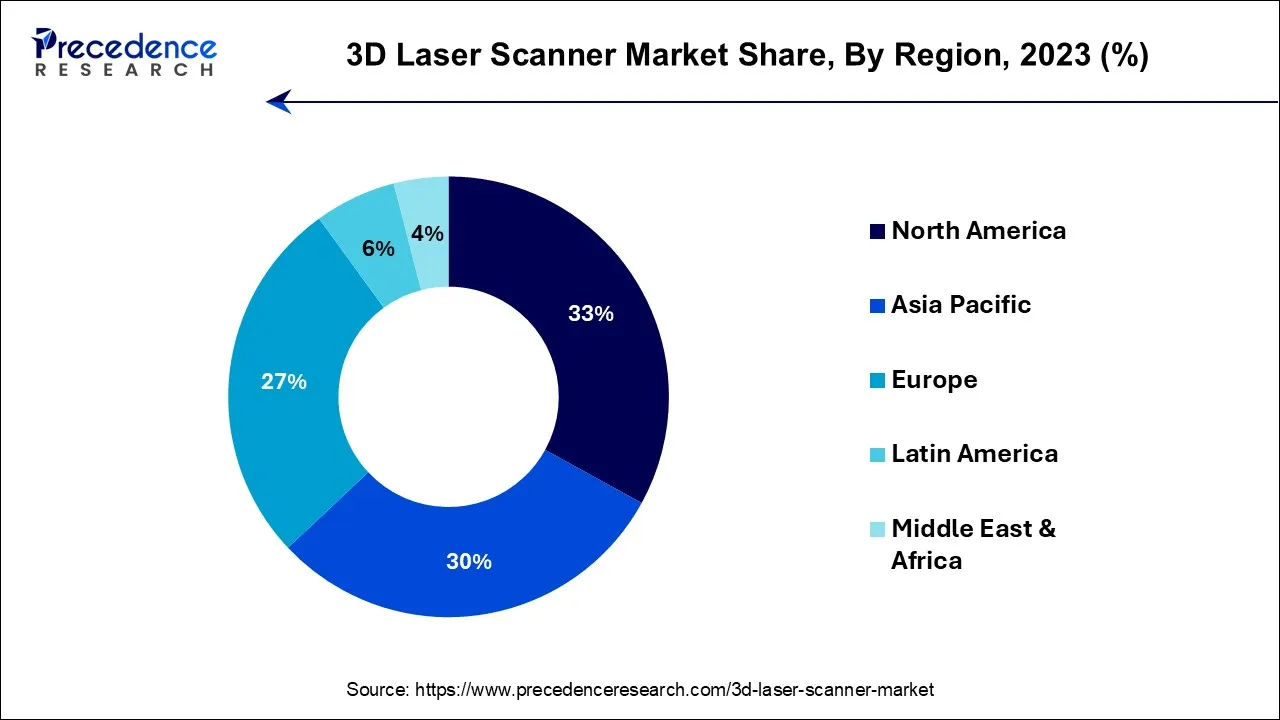What is the 3D Laser Scanner Market Size?
The global 3D laser scanner market size is valued at USD 3.16 billion in 2025 and is predicted to increase from USD 3.65 billion in 2026 to approximately USD 13.28 billion by 2035, expanding at a CAGR of 15.44% from 2026 to 2035. The market is driven by factors such as the rising adoption of scanners in various industries and the rising technological advancements in the medical sector.

3D Laser Scanner Market Key Takeaways
- North America led the global market with the highest market share of 33% in 2025.
- By region, Asia Pacific is expected to grow fastest during the forecast period.
- By technology types, the laser triangulation segment accounted for the largest market share in 2025.
What is a 3D Laser Scanner?
The 3D laser scanner market deals with a device that uses a line of laser light to digitally record the geometry of actual items. 3D laser scanning is a non-contract process for collecting data on their appearance and shape and analyzing real-world items. The information collected is then used to create 3D models. In addition, 3D laser scanner technology saves labor, money, and time throughout the manufacturing procedure while also improving output quality.
The major most active factor driving the 3D laser scanner market growth is extensive applications in a variety of end-use industries. The adoption of novel technologies in various businesses is expected to drive market growth during the forecast period. In addition, the increasing presence of iris scanning, face recognition well-known players, and rising advanced technology in the construction industry is further anticipated to drive the market growth.
How is AI contributing to the 3D Laser Scanner Industry?
AI is fundamentally changing the landscape of 3D laser scanning by its involvement in the various stages, especially in data processing, where it is manually done, and also in decision making, wherein the workflow of the entire manufacturing process is done intelligently in real-time. Its point cloud to 3D model conversion is not only quick but also very efficient, as it can spot any abnormalities and therefore correct them before the products are sent out for sale.
The same goes for the laser operations, as they are being handled through AI dynamically, and the prediction of equipment maintenance needs is also occurring. With the combination of ML and AI technologies, the digital twin is being developed, and design is being created faster.
3D Laser Scanner Market Growth Factors
The market for 3D laser scanners is expanding due to the rising need for quality control, globalization in 3D printer design, and significant application across several sectors. 3D laser scanners are tools that examine an object and gather information depending on how it appears and how it is shaped. The gathered information is transformed into a 3-dimensional digital representation. The 3D laser scanner market is expanding due to reasons such as the growing demand for 3D printers on a global scale, the growing popularity of handheld 3D scanners, and the high degree of quality control as well as inspection standards provided by these scanners. The data gathered is utilized to build 3D models. Another significant element driving the market development is the mounting of various applications of 3D laser scanners by the numerous end-user verticals, including aerospace and military, healthcare, architecture & construction, automotive, energy, power, and others.
Growing market potential will be further facilitated by the market's evolution from 3D scanners, particularly in emerging nations. The growing demand for enormous amounts of data to be collected for analysis, modeling, and research reasons is promoting market expansion. The high cost of a 3D laser scanner will provide a barrier to the market's expansion, nevertheless. The availability of conventional substitutes for 3D laser scanners will also have an impact on market growth. A structured-light 3D scanner is a 3D scanning device that projects many lines from a single light source onto the item being tracked by one or more cameras in order to measure its three-dimensional geometry. In contrast, a laser scanner produces several laser dots on a single object in succession.
Applications for structured light scanners include obstacle detection systems for unmanned aircraft, automated optical inspection in high-speed manufacturing lines, volume measurement of engineering parts, reverse engineering of objects to produce CAD data, motion as well as environment capture for virtual reality games, measurements for apparel retailing, and motion and environment capture for motion capture systems. Hand-held 3D scanners are able to readily include the same thanks to features like rapid setup. As a result, numerous portable 3D scanners for 3D printing employ structured light technology. Trigonometric triangulation is used by the system to project a pattern of light onto the object that will be further scanned.
- 3D laser scanners are advancing technologically and producing scans that are more precise. The manufacturing and distribution of 3D laser scanners are also getting more affordable as a result of advancing technical advancements.
- The last several years have seen a rise in the use of 3D laser scanning across a wide range of sectors, including media and entertainment, gaming and technology, healthcare, manufacturing, and transportation. As a result, it is projected that the market for 3D laser scanners would grow dramatically during the next several years.
- One of the most important aspects driving the boom in the 3D laser scanner industry is the flexibility of mobility built into the device.
- Due of their growing use in the construction industry, 3D laser scanners are becoming more popular. With the most recent technology developments, a 3D laser scanner may accomplish the Objective of gathering topographical information at regions that people cannot access through the automobile Internet of Things (IoT). Future expansion in the automation sector is anticipated to be fueled by soaring demand.
3D Laser Scanner Market Trends
- The rising adoption of 3D laser scanners in various industries such as entertainment, construction, and healthcare is expected to drive market growth.
- The rising growth in the usage of laser scanning devices in the architecture sector is also expected to enhance market growth.
- The market for 3D laser scanners is expanding due to the rising need for quality control, globalization in 3D printer design, and significant application across various sectors.
- The 3D laser scanner market is expanding due to reasons such as the growing demand for 3D printers on a global scale, the growing popularity of handheld 3D scanners, and the high degree of quality control as well as inspection standards provided by these scanners.
- Another significant element driving the market development is the mounting of various applications of 3D laser scanners by the numerous end-user verticals, including aerospace and military, healthcare, architecture & construction, automotive, energy, power, and others.
Market Outlook
- Industry Growth Overview:
Manufacturing healthcare and automotive industries are the primary factors contributing to increased advanced scanning usage through their adoption of the technology. - Sustainability Trends:
The trend towards sustainability calls for the use of recyclable materials, energy-saving production, and eco-friendly laser development with minimal waste. - Global Expansion:
The world market is growing rapidly, with the Asia-Pacific region being the main source of demand for scanning technologies to be deployed extensively. - Major Investors:
Hexagon AB, FARO Technologies, Trimble, Nikon, and Carl Zeiss AG are some of the major investors that are backing the industry and technology innovations. - Startup Ecosystem:
Startups are growing under the umbrella of investors who are maturing with sophisticated applications, automation workflows, and intelligent scanning technology solutions.
Market Scope
| Report Coverage | Details |
| Market Size in 2025 | USD 3.16 Billion |
| Market Size by 2035 | USD 13.28 Billion |
| Growth Rate from 2026 to 2035 | CAGR of 15.44% |
| Largest Market | North America |
| Base Year | 2025 |
| Forecast Period | 2026 to 2035 |
| Segments Covered | By Technology |
| Regions Covered | North America, Europe, Asia-Pacific, Latin America, and Middle East & Africa |
Market Dynamics
Key Market Drivers
Numerous Uses in a Range of End-Use Industries to Promote Market Growth
One of the key factors promoting the development of the 3D laser scanner market is the device's versatility with regard to mobility. This is the most reliable technology for delivering visualization at real time and more accuracy as compared to other solutions on the market. The market for 3D laser scanners is expected to grow in the coming future as a result of the widespread use of cutting-edge technology in enterprises across all sectors.
It is anticipated that nations like the US would study crime scenes using 3D laser scanners. Recent demonstrations in Nevada used 3D laser scanning technology to help investigators crack cases involving firearm trajectories. Additionally, it's conceivable to see these 0 to R3 miniature artificially intelligent automobiles patrolling and securing Dubai's streets. The truck would be equipped with a drone that can be used to scan objects from a radius of 330 ft for suspect bombs, vehicles, and criminal activity.
Building industry experts are rapidly becoming aware of the significance of 3D laser scanners. By leveraging cutting-edge technology, a 3D laser scanner can gather topographical data in places that the Internet of Things cannot reach. The market for 3D laser scanners is anticipated to be driven by this goal to improve automated workflow designed with a lower risk of human error.
Key Market Challenges
High Installation and Maintenance Costs Limit Market Growth
Despite having many benefits, 3D laser scanners have several application restrictions, which restrain market expansion. For instance, two significant challenges limiting the 3D scanning business are the starting high cost of high-resolution 3D scanners and the industry's reliance on non-3D sectors.
Similar to this, high installation and maintenance expenses might limit market growth. The adoption of previous 3D laser scanner alternatives may be slowed down even further by their simplicity of use.
Key Market Opportunities
Risk Mitigation Creating New Applications for 3D Scanners
The key to a successful capital project execution is risk minimization. Due to either poor documentation or control methods, the expenses or timeline will inevitably go over budget while the projects are being implemented. Thus, the use of 3D scanning in conjunction with the use of modular building techniques, where timetable sensitivity is an unavoidable need, is a proven strategy for controlling such risk factors for brownfield projects or projects that need to be renovated. The installation expenses were reduced by 6-8% and the schedule was compressed by 10% thanks in large part to laser scanning. In addition to include these costs and scheduling considerations, 3D scanning is now an important tool for analyzing design and engineering plans to identify conflicts with the current situation and suggest better solutions. Additionally, 3D scanning techniques make sure that project stakeholders are in a better position to comply with safety and legal requirements.
3D Laser Scanner Market Segment Insights
Technology Insights
With a share of 32.9% in 2025, Laser Triangulation will lead the 3D Laser Scanner Market in comparison to the other technologies. All 3D scanners have a range constraint that prevents them from scanning things from all distances. Therefore, different technologies such as laser triangulation, structured light technology, and pattern fringe technology are used by scanners with different ranges such as medium-range scanners, short-range scanners, long-range scanners. Each of the scanners has a range of distances at which an object can be scanned, such as less than one meter, one meter to 150 m, and two meters or more. Depending on device's range, these scanners use a variety of technologies. For short-range devices, structured light, laser triangulation, and pattern fringe triangulation are employed, but for medium- and long-range devices, the phase-based as well as pulse-based methods are utilized.
3D Laser Scanner Market Regional Insights
The U.S. 3D laser scanner market size is accounted for USD 729.96 billion in 2025 and is projected to be worth around USD 3,089.94 billion by 2035, poised to grow at a CAGR of 15.52% from 2026 to 2035.

The North America, generated over 33% of revenue share in 2025. The United States is dominating the region since it maintained its growth rate over the projection period. The size of the USA 3D laser scanner industry is expanding as more cameras are using 3D laser scanners to look into tragic traffic accidents. The market is being driven throughout the projected period by the existence of well-known companies, facial recognition, as well as iris scanning. The prevalence of computing systems used for 3D virtualization is rising since the price of computers as well as graphics processors has decreased recently. Additionally, expanding 3D scanning makes it possible to replace a part quickly and precisely, driving the forecasted growth of the 3D laser scanner market. Similar to this, such scanners are being widely used in several end-use industries, such as the automotive as well as healthcare sectors, which is driving the growth of the US 3D laser scanner market.

The Europe region accounts for 27% of the market in 2025. Due to the growing use of 3D laser scanner technology in palaeontology research, the United Kingdom now commands the largest share of the industry. In the UK 3D laser scanner market throughout the anticipated time, researchers will utilize this method to investigate how plants and extinct animals interact. Demand is anticipated to increase over the course of the projection period due to the rising automotive industry and leadership in the production of passenger vehicles.
In contrast, Germany is anticipated to win the majority of the market due to the industry's quick advancement of 3D scanning technology. German business DAVID created the DAVID Structured Light Scanner (SLS-3) 3D scanner. The scanner is around $4,000 and may be used for reverse engineering, inspection, and archaeology, among other things. The market for 3D laser scanners in Germany is being driven by the increasing usage of reverse engineering techniques. German automaker BMW was a pioneer in implementing 3D printing and 3D scanning technology.
Asia-Pacific economies expand rapidly, propelled by industrialization, urbanization, and government manufacturing incentives. Demand for scanning technology mainly comes from the electronics, automotive, and semiconductor industries and is also supporting the development of localized cost-effective solutions, platform integration, smart factories, and drone-based LiDAR deployments.
China is at the forefront of the manufacturing industry with its considerable presence in electronics and automotive sectors, which motivates the use of smart automation and optical inspection. The growing scale of the industry opens up many applications for 3D scanning and laser cutting, thus the rapid adaptation of advanced scanning technologies of various kinds in the factories.
3D Laser Scanner Market-Value Chain Analysis
- Raw Material Procurement: Sourcing high-purity silicon wafers and process gases, ensuring quality, efficiency forming a manufacturing foundation.
Key Players: SUMCO, Shin-Etsu Chemical, Linde, Air Products - Wafer Fabrication: Transforming raw wafers into functional circuits or optical components using complex, controlled physical and chemical processes.
Key Players: TSMC, Intel, Samsung - Photolithography and Etching: Patterning circuits with light, then removing material chemically to structure the required device shapes.
Key Players: Applied Materials, Lam Research - Doping and Layering: Introducing impurities to control electrical properties and depositing material layers to build a full device structure.
Key Players: Applied Materials, Tokyo Electron - Assembly and Packaging: Protecting the fabricated device, connecting external interfaces preparing the finished 3D laser product for distribution.
Key Players: Amkor Technology, ASE Technology Holding
Top Companies in the 3D Laser Scanner Market & Their Offerings:
- Basis Software, Inc.: Basis Software gives point cloud software that allows users to process, manage, and interact with huge datasets of 3D laser scans easily and quickly.
- FARO: FARO's portable 3D laser scanners are combined with software for measurement, inspection, and modeling workflows, thus increasing accuracy through various scanning applications.
- Hexagon AB: The company is known for offering groundbreaking laser trackers and scanners that provide extremely accurate 3D data for industrial metrology, geospatial mapping, and advanced visualization.
3D Laser Scanner Market Companies
- Basis Software, Inc.
- FARO
- Hexagon AB
- 3D Digital Corporation
- ShapeGrabber Inc.
- JoeScan
- Riegl Laser Measurement Systems
- Kreon Technologies
- CREAFORM
- Perceptron Inc.
- Nikon Metrology NV
- Trimble
- Zeiss
- Topcon
Recent Developments
- In November 2025, Hikrobot introduced a 3D laser profile sensor in India, which further improved the production of consumer electronics, lithium batteries, and PCBs. The device features laser triangulation, allowing for very accurate, non-invasive measurements and instant imaging.
(https://www.manufacturingtodayindia.com)
- In September 2025, Scantech's SIMSCAN Gen2 was born, which is a small-sized, industrial-grade 3D laser scanner. This scanner is capable of fast, precise scanning of small to medium parts, even in difficult spaces.
3D Laser Scanner Market Segments Covered in the Report
By Technology
- Laser triangulation
- Structured Light Technology
- Pattern Fringe triangulation
- Pulse-based
- Phase shift
- Others
By Geography
- North America
- Europe
- Asia-Pacific
- Latin America
- The Middle East and Africa
For inquiries regarding discounts, bulk purchases, or customization requests, please contact us at sales@precedenceresearch.com
Frequently Asked Questions
Ask For Sample
No cookie-cutter, only authentic analysis – take the 1st step to become a Precedence Research client
 sales@precedenceresearch.com
sales@precedenceresearch.com
 +1 804-441-9344
+1 804-441-9344